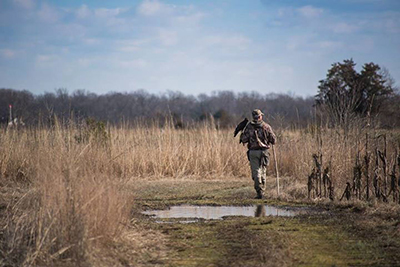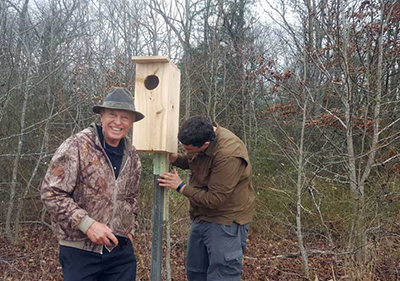
As a young mechanic just out of the Air Force, Bob Spiering said the whistling call of the bobwhite quail went silent. It was the early 1980s in Maryland’s Eastern Shore, and the decades of disappearing quail populations had finally hit Caroline County. The years where he and a buddy could sustainably harvest the iconic species, known as the “prince of game birds,” appeared to be over.
It was a loss—in many ways. Spiering grew up quail hunting with his dad and grandfather. “My grandfather was the biggest quail hunter in the world,” he said. “I was probably 10 years old when I started walking along with him, watching the setters get the birds.”
Could they help bring the quail back? Spiering’s family gave it a shot.
His dad owned a farm—which has since been bought by Spiering—where he farmed every bit of tillable land and harvested all the crops. What they could leave for wildlife were the ditch banks, the sloped land alongside the ditches that drained the fields and made them usable.
He worked with the U.S. Department of Agriculture, which would cover the costs of planting those ditch banks with native grasses. The grasses provide cover for quail to travel the field edges, to nest and to raise young.
But the quail didn’t come.
Time passed, and Spiering picked up the baton when he bought the farm in the headwaters of the Choptank River watershed. As his wife, Judy Spiering, said, “Bob was interested in hunting, in establishing it back to the kind of environment that was good for birds, deer and different wildlife.”
With the income from his automotive garage downtown, Spiering was able to leave more of the land for wildlife. Of the 175 acres of forests, meadows and fields, he tills 50 acres and manages the rest for wildlife.
He brought in a biologist to guide him. Turned out that Spiering needed to do more than just grasses. The biologist suggested he restore weedy areas, shrubby cover and other habitats needed by the birds. He enrolled the farm in a federal program to manage for wildlife, worked with the U.S. Fish and Wildlife Service to create hedgerows for more cover and food, and disked fallow areas so that the disturbance would promote certain types of plants. He grew corn, soybeans, alfalfa and clover, leaving some of it for the animals.
The rabbits started to show up “like crazy,” Spiering said.
But he kept waiting. Habitat restored for quail benefits other wildlife, including turkeys, deer, rabbits, several turtle species and many songbirds.

One day, he finally heard the call. The quail had returned.
“I turned the farm into a place for rabbits, deer and a few quail. I see one almost every day now,” Spiering said, noting he has two quail coveys—families—on the farm, and room for one more.
While the Maryland Department of Natural Resources estimates that the state’s bobwhite population has dropped more than 90 percent over the past 50 years, efforts like those at the Spiering farm mean progress. More than 30,000 acres across state wildlife management areas and private lands enrolled in the USDA Conservation Reserve Program are managed with quail in mind. In 2016, around 4,200 acres in Maryland were burned, disked, grazed, planted or protected with benefits to quail, according to the National Bobwhite Conservation Initiative.
For Spiering, the work didn’t end with quail. He turned to waterfowl.
With more than 60 acres enrolled in the Natural Resources Conservation Service’s Wetland Reserve Program, Spiering set out with NRCS and the Service to restore part of it to a freshwater wetland.
“Portions of the Spiering land, like many farms on the eastern shore, were originally wetlands that are not ideal for growing crops,” said NRCS biologist Steve Strano. “By restoring the land to wetlands and riparian buffers, it now provides water quality benefits as well optimal wildlife habitat.”
To manually turn back time, the ditches were filled to a natural level, instead of allowing water to continue to drain through the ditches. A ridge (berm) was added to further retain water. Last, the water leaving the wetland and headed toward Heron Run goes through a constructed basin that maintains flow and improves water quality.
Three intense rain events occurred after the 10-acre wetland was finished in October 2016. The pseudo monsoon put the project to the test. Service biologist Rich Mason noted that they expected the wetlands to attract ducks, geese, wading birds, shorebirds and songbirds.
Within days, shorebirds including greater and lesser yellowlegs and Wilson’s snipes, showed up in the shallow water.
Shortly after, ducks and geese arrived. “Turtles, frogs, toads, and salamanders will also live in the restored wetlands,” Mason said. “The wetland buffers and grasslands will provide excellent areas for pollinators, too.”
The ducks received nesting boxes the following spring, with the help of a Girl Scout troop. In 2017, Spiering saw at least five families of wood ducks.
“The ground was mostly wet anyway, and a pain to farm,” he said. “I’m way happier having ducks in there. If I was relying on the farm for income it’d be different. Now it’s a place to relax.”
His wife likes the comfort of knowing the area around their farmhouse won’t be developed.
“My goal is to not have a bunch of houses around me,” she said. “I take hikes and take my grandchildren on walks. They see the ducks and the different animals, a snake or two every once in awhile, turtles.”
Partnering with the government worked out just fine for him, Spiering said. What’s next? A pond, maybe, and retirement from the automotive business.
“I’m just the supervisor these days, and I sneak off as much as possible,” he joked.
To enjoy the call of the bobwhite, perhaps.
 Sign In
Sign In
 Sign In
Sign In
